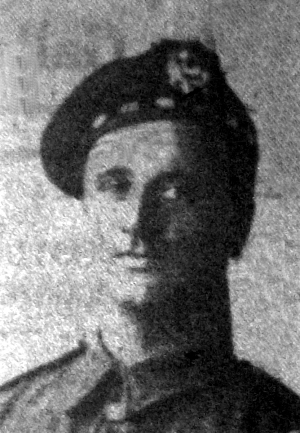
41829. Cameronians (Scottish Rifles), 10th Battalion
Walter Flesher was born in Ossett on the 29th May 1883 and baptised at Ossett Holy Trinity Church on the 22 nd July 1891 along with three of his siblings. Walter Flesher was the fourth child and third son of Bramley-born mill hand Thomas Flesher and his wife Doncaster-born Miriam (nee Pashley), who married in the Wakefield area in 1875.
The couple had seven children from their marriage, but one died before April 1911. All of the six surviving children, five boys and a girl, were born in Ossett between 1876 and 1903. Thomas and Miriam Flesher settled in Ossett in the mid-1870s and by 1891 with five children, four boys and a girl, they were living in two rooms at Dale Street, Ossett. Thomas Flesher was working as a cloth tenterer.
By 1901 the family were living off Bank Street, Ossett and Walter had begun work as a woollen spinner. In 1911 Thomas and Miriam Flesher were living in a four-roomed home at 81, Springstone Avenue, Ossett with five of their six children aged between eight and thirty years. Like his father, Walter was working as a mill hand in a woollen mill.
Walter Flesher‘s army service record has not survived, but it is known that he enlisted at Dewsbury and first joined Highland Light Infantry with service number 7633 and later service number 241851 then at some stage transferred to the 10th Battalion, Cameronians (Scottish Rifles).
The 10th (Service) Battalion, Cameronians (Scottish Rifles) was raised at Hamilton in September 1914 as part of Kitchener’s Second New Army and joined 46th Brigade in 15th (Scottish) Division. They moved to Bordon for training and in February 1915 went into billets at Winchester then moved on to Park House and Chiseldon Camps on Salisbury Plain in April 1915. The Battalion received an embarkation notice on the 4th July 1915 and on the 10th July 1915 they travelled from Chiseldon to Folkestone, embarking at 11.15 pm on S.S. Victoria, arrived at Boulogne at 3:45.pm on the 11th July. In fine weather, the Battalion marched to Ostrohove rest camp.
According to the 10th Battalion, Cameronians War Diary from the 1st of April 1918, they were in the Arras Sector. On the 4th of April, they relieved the Black Watch at Imperial Tunnel, St Sauveur and on the same date a gun pit received a direct hit from a German shell. Casualties numbered five other ranks killed and another twelve wounded. These were the only casualties for the 10th Battalion Cameronians in April 1918 and one of those unfortunate to be killed was Private Walter Flesher.
The “Ossett Observer” 1 had this obituary for Walter Flesher:
“Another Ossett Soldier Gives His Life – Another Ossett man who is officially reported to have lost his life in the war is Private Walter Flesher (34), Highland Light Infantry, whose parents reside in Denholme-drive. The deceased had been in the army about two years and went to France about ten months ago. A notice from his regimental headquarters states that he was killed on April 4th. He used to work at Messrs. F. Lawrence and Son’s mill, Dewsbury-road, and was a member of the Ossett Temperance Institute and the Conservative Club. His eldest brother, Herbert, is with the anti-aircraft guns in this country, and another brother, Thomas, is with the engineers in France.”
Walter Flesher was posthumously awarded the British and Victory medals. He did not serve overseas before 31st December 1915, although it is possible that he may have enlisted prior to this date.
Private Walter Flesher was killed in action on the 4th April 1918 and is remembered on Bay 6 at the Arras Memorial,2 Pas de Calais, France. The Arras Memorial is in the Faubourg-d’Amiens Cemetery, which is in the Boulevard du General de Gaulle in the western part of the town of Arras. The cemetery is near the Citadel, approximately 2 kms due west of the railway station.
The French handed over Arras to Commonwealth forces in the spring of 1916 and the system of tunnels upon which the town is built were used and developed in preparation for the major offensive planned for April 1917.
The Commonwealth section of the Fauborg D’Amiens Cemetery was begun in March 1916, behind the French military cemetery established earlier. It continued to be used by field ambulances and fighting units until November 1918. The cemetery was enlarged after the Armistice when graves were brought in from the battlefields and from two smaller cemeteries in the vicinity.
The cemetery contains over 2,650 Commonwealth burials of the First World War, 10 of which are unidentified. The graves in the French military cemetery were removed after the war to other burial grounds and the land they had occupied was used for the construction of the Arras Memorial and Arras Flying Services Memorial.
The adjacent Arras Memorial commemorates almost 35,000 servicemen from the United Kingdom, South Africa and New Zealand who died in the Arras sector between the spring of 1916 and 7 August 1918, the eve of the Advance to Victory, and have no known grave. The most conspicuous events of this period were the Arras offensive of April-May 1917, and the German attack in the spring of 1918. Canadian and Australian servicemen killed in these operations are commemorated by memorials at Vimy and Villers-Bretonneux. A separate memorial remembers those killed in the Battle of Cambrai in 1917.
References:
1. “Ossett Observer”, 11th May 1918